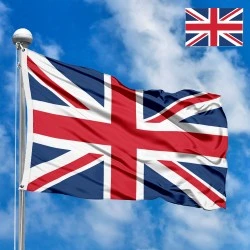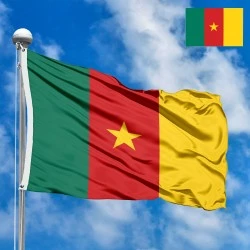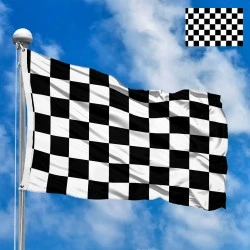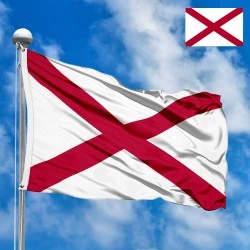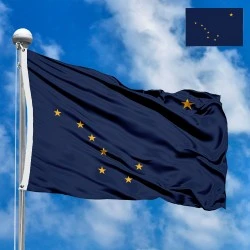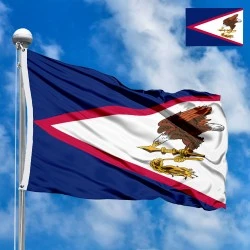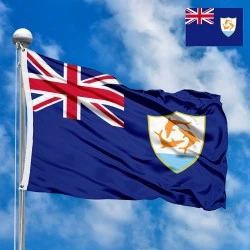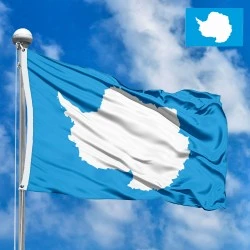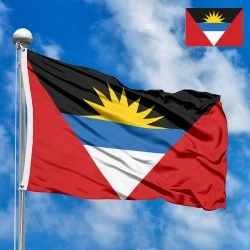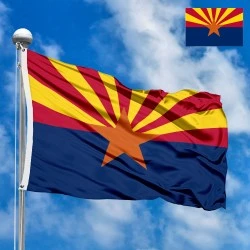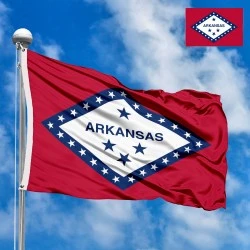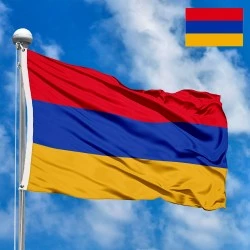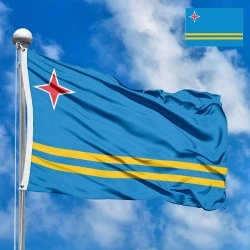Flag of Northern Ireland
- Flag Type: Regional, Historical
- Proportions (official): N/A
- Official name: Northern Ireland
- Local name: Tuaisceart Éireann
- Sovereignty (year): NO (Constituent country of the United Kingdom)
- Capital: Belfast
- Large cities: Belfast, Derry/Londonderry
- Population: 1,911,000 (2022 est.)
- Religions: Protestantism (42.3%), Catholicism (42.3%)
- Area (km²): 14 130
- Highest point: Slieve Donard (850 m)
- Lowest point: Sea level (0 m)
- Currency: British Pound (GBP, £)
- Languages: English
Flag Information
General information
Demography and Culture
Economy and communications
- All Flags
- Flags of Countries by Continent
-
Flags of Organizations
- Flags of UN countries
- Flags of the European Union countries
- Flags of NATO countries
- Flags of the countries of the Organization of Islamic Cooperation
- Flags of the countries of the Organization of American States
- Flags of the Arab League countries
- Flags of the African Union countries
- Flags of the countries of the Union of South American Nations
- Flags of the Commonwealth of Nations
- Flags of the countries of the Secretariat of the Pacific Community
- Flags of the Nordic Council countries
- Flags of the Caribbean Community
- Flags of the countries of the Association of Southeast Asian Nations
- Flags of the East African Community
- Flags of the countries of the Organization of Turkic States
- LGBT Community Flags
- Historical Flags
- Ethnic Flags
- Flags of the USA (states)
Description
When discussing the flag of Northern Ireland, it's crucial to understand that this region currently does not possess an officially recognized flag of its own. The flag most commonly associated with Northern Ireland, and still widely used by unionists, in sports, and in unofficial contexts, is known as the Ulster Banner. This banner served as the official flag of the Government of Northern Ireland from 1953 until that government was abolished in 1973.
Description and Elements of the Ulster Banner
The Ulster Banner is a heraldic banner derived from the former coat of arms of the Government of Northern Ireland. Its design incorporates several key elements, each with its own historical and symbolic meaning:
-
White Field: The main background of the flag is a white field. This color is traditionally associated with purity, peace, and truth.
-
Red Cross of Saint George: Superimposed on the white field is a large red cross, similar to the cross on the flag of England. This indicates Northern Ireland's historical and ongoing connection to the United Kingdom. Although sometimes referred to as the de Burgh cross (after the Anglo-Norman family that ruled Ulster), its resemblance to Saint George's Cross is a clear symbol of British identity.
-
Six-Pointed Star: Centered on the red cross is a large white six-pointed star. This star symbolizes the six of the nine counties of the historical province of Ulster that constitute Northern Ireland: Antrim, Armagh, Down, Fermanagh, Londonderry (Derry), and Tyrone.
-
Red Hand of Ulster: Within the center of the six-pointed star is a red fisted hand, or the "Red Hand of Ulster." This is an ancient heraldic symbol associated with the Irish province of Ulster and, specifically, with the O'Neill clan. Legends regarding the Red Hand's origin vary, but the most prominent tells of a race to claim land in Ulster, where one contender severed his hand and threw it ashore to be the first to touch the land, thus claiming it. The Red Hand symbolizes strength, courage, and determination.
-
Crown: Above the six-pointed star with the Red Hand is a crown (originally the Tudor Crown, later the St Edward's Crown). The crown is a direct symbol of the British monarchy and emphasizes Northern Ireland's loyalty to the United Kingdom.
Dimensions, Colors, and Placement of Elements
The Ulster Banner typically had proportions of 3:5. The elements of the flag are arranged as follows:
-
The Red Cross of Saint George extends across the center of the flag.
-
The six-pointed star is positioned at the intersection of the cross's arms.
-
The Red Hand is centered within the star.
-
The crown is placed above the star, directly surmounting the Red Hand.
The exact shades of the colors (especially red and the gold for the crown) are defined by heraldic standards.
-
Red (Cross and Hand): A rich, deep red.
-
White (Field and Star): Pure white.
-
Gold (Crown): Bright gold.
History of Creation and Adoption of the Flag
The history of the Ulster Banner is closely tied to the partition of Ireland and the establishment of Northern Ireland as a distinct administrative entity within the United Kingdom in 1921. Prior to this, all of Ireland was part of the United Kingdom, and the official flag was the Union Jack.
When Northern Ireland gained its own devolved government, there arose a need for its own symbol. In 1924, the coat of arms of Northern Ireland was designed. The designer of the arms, and consequently the basis for the future flag, was Sir Nevile Wilkinson, the Ulster King of Arms. This coat of arms was based on the traditional arms of the province of Ulster, which included the Red Hand and a red cross (historically associated with the de Burgh family).
The Ulster Banner, as an armorial banner, was officially adopted by the Government of Northern Ireland in 1953, coinciding with the coronation of Queen Elizabeth II. It served as the official flag of the Northern Ireland government and was widely used to represent the region, including at international sporting events such as the Commonwealth Games and by national football teams.
Disuse and Unofficial Use
The official status of the Ulster Banner was lost in 1973 when the Government of Northern Ireland was abolished following the passage of the Northern Ireland Constitution Act 1973. This occurred amidst "The Troubles"—a period of conflict between nationalists (predominantly Catholic, advocating for a united Ireland) and unionists (predominantly Protestant, advocating for Northern Ireland's continued inclusion in the UK). The dissolution of the government meant that the flag, which was its armorial banner, lost its official standing.
Since then, Northern Ireland has not had an officially recognized flag of its own. The only official flag used by the UK government in Northern Ireland is the Union Jack.
However, despite its loss of official status, the Ulster Banner continues to be widely used by loyalists and unionists as a symbol of their British identity and allegiance to Northern Ireland. It can often be seen flying in loyalist areas, during Orange Order parades, and at sporting events where it represents Northern Ireland. This usage is unofficial but deeply ingrained in the culture of these communities.
Significance for Residents
The flag's significance to the people of Northern Ireland varies greatly depending on their political and cultural perspectives:
-
For Unionists and Loyalists: The Ulster Banner is a powerful symbol of their British identity, loyalty to the Crown, and Northern Ireland's place within the United Kingdom. It recalls a period of self-governance and serves as an expression of their cultural heritage and political convictions. The Red Hand and the six stars symbolize their connection to Ulster and the six counties they consider their homeland.
-
For Nationalists and Republicans: The Ulster Banner is perceived as a symbol of British dominance and the partition of Ireland. For them, it is a reminder of a period of discrimination and conflict. They prefer to use the Irish Tricolour, which symbolizes a united Ireland and peace between Catholics and Protestants.
This deep polarization regarding the flag reflects the broader political and social divisions within Northern Ireland. In attempts to find more neutral symbols to represent Northern Ireland, various new flag designs have been proposed, but none have gained widespread acceptance. Some public bodies and sports teams use neutral symbols such as the Shamrock, which is associated with all of Ireland.
Interesting Facts
-
Absence of an Official Flag: Northern Ireland is the only region of the United Kingdom that does not have an officially recognized regional flag (unlike England, Scotland, and Wales, which have their own flags).
-
Sporting Events: The Ulster Banner is still widely used to represent Northern Ireland in international sports competitions, such as the Commonwealth Games, FIFA football matches, and PGA Tour golf tournaments, underscoring its role as an unofficial but commonly accepted sporting symbol.
-
Discussions for a New Flag: Following the Belfast Agreement (Good Friday Agreement) of 1998, there have been recurring discussions about devising a new, more inclusive flag for Northern Ireland that could be acceptable to both communities. However, consensus on this issue has not been reached.
-
Symbolism of the Red Hand: The Red Hand of Ulster symbol is one of the oldest and most enigmatic symbols in Irish heraldry, with roots in ancient Celtic myths and legends.
-
Union Jack as Official Flag: On all government buildings in Northern Ireland and at official events, only the Union Jack is used by the UK government.
In the demonstration images, full-size flags are shown with proportions of 2:3, and hand-held flags with proportions of 1:2.
Donation
Download
Completely free for commercial and non-commercial use (public domain).
You can freely use them in your news magazines, websites, software, mobile applications.
We appreciate a backlink to https://flagssite.com
Raster files - Flag of Northern Ireland (PNG, JPG)
 Waving flag
Waving flag
- PNG format (transparent background), 72dpi, dimensions in Pixels (px), aspect ratio 3:4.
- 15х20 px
- 30х40 px
- 60х80 px
- 120x160 px
- 240x320 px
 Sizes:
Sizes:
"v15" - image size (by height); if necessary, replace with available: v15, v30, v60, v120, v240.
!!! For resizing, use the Latin (eng) keyboard layout.
<img src="https://flagssite.com/flags/v15/20252.png" alt="Flag of Northern Ireland">
 Round flag
Round flag
- PNG format (transparent background), 72dpi, dimensions in Pixels (px), aspect ratio 1:1.
"d15" - image size (diameter); if necessary, replace with available: d15, d30, d60, d120, d240.
!!! For resizing, use the Latin (eng) keyboard layout.
<img src="https://flagssite.com/flags/d15/20252.png" alt="Flag of Northern Ireland">
 Rectangular flag 2:3
Rectangular flag 2:3
- JPG format, 72dpi, dimensions in Pixels (px), aspect ratio 2:3.
"h30" - image size (by height); if necessary, replace with available: h15, h30, h60, h120, h240, h360, h480.
!!! For resizing, use the Latin (eng) keyboard layout.
<img src="https://flagssite.com/flags/h30/20252.jpg" alt="Flag of Northern Ireland">


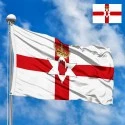
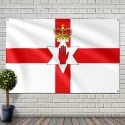
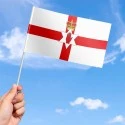


 Sizes:
Sizes:
 Sizes:
Sizes:
